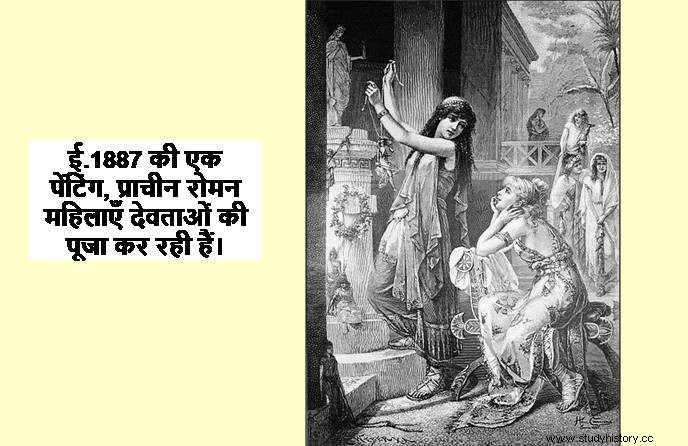
Indo-European Religion
In the context of Indian civilization and culture, the civilization and culture of Europe dates back thousands of years. Although the time of the composition of the Rigveda in India has been disputed by Western historians, on the basis of the evidence discovered by modern Indian scholars, it is believed that the Rigveda was composed about 4000 to 3000 years before Christ. Whereas the thought tradition of religion and philosophy in Europe is indicated to have started about six centuries before Christ or sometime before.
However, ancient Greek and Roman religions started coming into existence during the period of post-Vedic sages. During this period, the religion of almost all of Europe including Rome and Greece was Indo-European religion. It was a pagan and polytheistic religion. 'An Invisible God' in Indian Religion The concept of God existed from the very beginning but Greek and Roman Indo-European religions did not have the concept of 'an invisible God'. They considered different gods and goddesses to be the masters of different forces of nature.
The Origin of the Greek Gods
The Romans were polytheistic from time immemorial. They mainly worshiped Greek gods. Zeus was the most important of the Greek gods. In fact, it was the deity called 'Dyaus', worshiped by the ancient Indian Aryans and mentioned in the Rigveda, who was considered the king of all the gods. The wife of Devraj Zeus was Heera. Zeus was the god of clouds, lightning and thunder. He used to carry thunder like Indra.
Many beautiful temples were built for them in ancient Greece (Greece). In ancient Roman religion, only Zeus was worshiped first, but later Jupiter was considered the main deity in place of Zeus. Jupiter has been called 'Dyauspitar' and 'Vrihaspati' in Indian texts and is considered to be the guru of the gods. Thus the religion of the ancient Romans was based on the Indo-Aryan religion. This is also confirmed by the fact that the city of Rome was founded by groups of Aryans who came from the east.
In the beginning, the Romans had respect for certain gods and goddesses. They mainly worshiped and offered sacrifices to Greek gods and goddesses, but as time went on, the Romans started adding new gods and goddesses to this list. He also included the god of war Mars (Mars) in the list of gods, whom he believed to be the father of the Roman settlers Remus and Romulus.
They considered Jupiter (Jupiter) to be the greatest deity who watched and protected the Romans from the sky. On a hill called the Capitoline in Rome, he built a temple of Jupiter in which he worshiped Jupiter's wife Juno (who was also Jupiter's sister) and Jupiter's daughter Minerva. They worshiped Neptune as the god of the sea and Pluto as the god of Hades.
Bacchus, Apollo, Mercury, Pluto, Saturn, Vulcan, Mithras were also included in the Roman gods. Of these, Apollo (Sun), Saturn (Saturn) and Mithras (Mitradi) were also worshiped by ancient Indian Aryans as gods. Sirius, Flora, Fortuna, Diana and Venus were also among the Roman goddesses.
These goddesses were also worshiped in Greek and German religions. There were also a few less important and minor deities (kumuphavake), with Nemesis as the god of vengeance, Cupid as the goddess of love, Pax as the god of peace, and Furize as the goddess of vengeance. .
Gradually they stopped worshiping Greek gods and goddesses and gods and goddesses of other countries and started worshiping only Roman gods and goddesses i.e. Mars, Jupiter, Juno, Minerva, Cupid and Furies etc. In the century before the birth of Christ, during the time of Julius Caesar, the Romans also included Roman emperors in the list of Roman gods.
Images and temples of Roman gods and goddesses were built and domestic animals were sacrificed to them. There is no information about the spiritual side of this religion now, but like the Indian and Greek people, they also used to fast and fast. They also believed in the miracles of gods and goddesses, their grace and the sufferings caused by them in anger and also offered human sacrifices to please the gods and goddesses. Roman emperors also followed this religion.
Distance from Judaism
Judaism appeared in Babylon about 2000 years before Christ. Contrary to the beliefs of polytheistic Greek religion, it was a monotheistic religion in which there was no belief in incarnations and gods and goddesses, but they believed in messengers and angels sent by God. Rome and Greece completely separated themselves from Judaism, but over time millions of Jews spread far and wide throughout the vast Roman Empire.
Their main center was 'Palestine' with the provincial capital 'Jerusalem'. The Jewish scripture is the 'Tanakh' written in the 'Hebrew', which is actually the first half of the Christian Bible. It is also called 'Old Testament'. It is written in this testament that one day the Messiah will come on earth and save the Jews.
Although there were millions of Jews living in the vast Roman Empire and the Jewish mainland Jerusalem and Palestine were also under the Roman Empire, the Romans never adopted Judaism and kept a distance from this religion till the end. He hated this religion and did not hesitate to kill Jews when given the opportunity.
Dissatisfaction with Rome's ancient religion
At the time when Jesus was not even born, voices of dissatisfaction with the ancient religion began to rise in Rome. The famous Italian poet Lucreti, in his poems, called life after death a hoax and ridiculed religious stereotypes. Lucreti was born during the time of the Roman emperor Octavian and his contemporaries were Virgil, Horace and Ovid.
